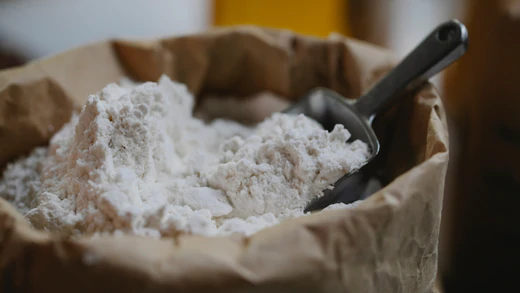Basil pesto is a light, fragrant, and incredibly tasty sauce. It’s light, refreshing, and summery, and it couldn’t be simpler to make with only a few fresh ingredients.
Pesto is simple to make. In a food processor, combine the garlic, almonds, and fresh basil, then sprinkle in the olive oil until you have a sauce.

Pesto is a herbaceous, nutty, salty, and garlicky sauce made with fresh basil leaves, garlic, pine nuts, olive oil, and aged hard cheese like Parmigiano-Reggiano. It comes from the Italian region of Liguria, where much of the country’s basil is cultivated, and it’s frequently combined with pasta for a simply delightful dish. The no-cook sauce is ideal for the summer.
Pesto is a traditional Italian sauce made of crushed garlic, pine nuts, coarse salt, basil leaves, and hard cheese such as Parmigiano-Reggiano or Pecorino, all combined with olive oil. The components are “crushed” or pounded in a marble mortar using a circular motion of a wooden pestle, according to tradition.
This pesto recipe is traditional in style, utilizing only the essential ingredients to create a simple but tasty sauce. While traditional pestos are produced with a mortar and pestle, a food processor or blender can be used to make things even faster and easier.
Pesto can be used in an infinite number of ways. Toss cooked pasta with pesto straight or, if desired, add a spoonful or two of the boiling pasta water to the pesto. Then throw in the cooked pasta and serve immediately, topped with a dusting of cheese.
Ingredients required :
- Fresh Basil leaves
- Pine Nuts
- Freshly grated parmesan cheese
- Garlic Cloves
- Extra virgin olive oil
- Salt
- Black Pepper
Fresh Basil Leaves :
To measure basil, just remove the thicker stems and put the leaves lightly into a measuring cup.Pine Nuts :
To bring out the flavor, lightly toast them. Freshly grated Parmesan Cheese :
Freshly grated Parmesan cheese for optimum flavor. (Alternatively, you can use pre-grated cheese to save time, but I recommend adding a touch extra because it’s not as tasty.FreshGarlic Cloves :
There’s no need to mince because your blender or food processor will do it for you.Extra Virgin Olive Oil :
For the best flavor, use high-quality oil.
Directions For Making Pesto Sauce:
The process is very easy. It involves a series of steps.
- In a blender or food processor, combine the dry ingredients until well blended. Everything but the olive oil, to be exact. Pulse until all of the ingredients are finely minced.
- Pour in the olive oil. Then, while the blender or food processor is still running, carefully dribble in the olive oil until the mixture is mixed. Puree until smooth, stopping to scrape down the sides as needed to ensure everything is evenly combined. Also, if your pesto is too thick, add a few teaspoons of extra olive oil or water to thin it down.
- Season to taste. Taste the sauce (you can dip a veggie stick or a piece of bread in it if you want) and season with more salt and pepper if necessary. If you want more of a certain taste, feel free to add more Parmesan, basil, or garlic.
- Finally, enjoy!
Pesto Recipe Variations:
There are so many different ways to make this basic basil pesto recipe. But here are a few!
Change up the greens/herbs:
Instead of basil (or in addition to basil), try baby arugula, spinach, parsley, cilantro, and so on.
Change up the nuts:
Instead of pine nuts (which might be expensive), try walnuts, pecans, almonds, pepitas, or any other beloved nut.
Remove the cheese:
To create vegan pesto, replace the Parmesan with 3-5 tablespoons (to taste) nutritional yeast.
Add some heat:
To kick pesto, I like to add a few pinches of crushed red pepper flakes or a few slices of jalapeno.
Different ways to use Pesto :
There are, of course, an infinite number of ways to use pesto! They are:
- Pasta or gnocchi sauce: Always delectable!
- Dip for raw vegetables or bread: It’s ideal as an appetizer or snack.
- Incorporated into mashed potatoes: Leave out some of the butter and replace with pesto!
- Salad dressing: Thin it up with extra oil or water, then combine with your favorite salad.
- Sauce on pizza or crostini: so simple and tasty.
- Soup garnish: This goes well with a variety of Italian soups.
Pesto goes nicely with almost any type of meat, chicken, or fish, as well as almost any type of cooked vegetable. As a result, you may use it as a finishing sauce for any protein or vegetable dish (especially grilled in the summertime).

CAARA’s Basil Pesto can also be used in preparation of Sandwiches.
CAARA’s Basil Pesto Collection
Here’s a list of our very own products inspired by the delectable CAARA basil pesto sauce:
- CAARA’s Stuffed Basil Pesto Loaf
- Smoked Chili & Basil Pesto Pizza
- CAARA Basil Pesto Pizza Kit
- Basil Pesto, Pine Nuts & Buffalo Mozzarella Pizza
- FarmLove Tomato, Buffalo Mozzarella & Basil Pesto Panuozzo
- Basil Pesto & Parmesan Chicken Salad with CAARA Farm Greens
If you’re someone who a chef at heart, here’s a list of European food recipes using CAARA’s basil pesto sauce
- Portobello on CAARA Sourdough with Whipped Tomato Chevre Cream, CAARA Basil Pesto & FarmLove Mizuna
- Eggplant, Goat Cheese & Asparagus Cannoli with Zucchini with Parmesan and Basil Ragu
- Artichoke & Walnut Pesto Pasta
- Basil Pesto Chicken Salad
Frequently asked questions about basil pesto:
Q1. What is the purpose of basil in pesto?
– Basil is a potently scented herb, and a small amount goes a long way. You can soften the pesto by replacing half of the basil with fresh baby spinach leaves. The pesto will retain its vivid green colour more easily, and the basil flavour will still be present, although not as strong.
Q2. How do you keep newly picked basil fresh?
– Basil leaves should be stored in the same way that salad greens are. Pick the leaves, wash them, and dry them before storing them in the fridge wrapped in a dry paper towel and packed in a plastic bag. Clean, dry, and ready to go. This baggie will house the basil for the next few days.
Q3. How to Store Pesto :
– To store pesto, place it in a tightly covered jar and place in the refrigerator for up to 3 days. Also, to prevent browning and to make pesto keep longer, drizzle a thin layer of olive oil on top of pesto to cover its surface. Alternatively, you can place a piece of plastic wrap immediately on top of the pesto’s surface.
CAARA offers Basil Pesto which is gluten-free, vegetarian and contains Cheese. Also, the shelf life of it is 5 days if refrigerated all the way through. CAARA has a wide range of dishes prepared using Basil Pesto. Some of them are Stuffed Basil Pesto Loaf, Basil Pesto Chicken Salad, Basil Pesto, and Cheddar Cheese Sourdough Sandwich.
For more European food recipes using basil pesto, check out the CAARA blog!


